
Concept explainers
Consider dimensionless velocity distribution in Couette flow (which is also called generalized Couette flow) with an applied pressure gradient which is obtained in the following from in Example 9-16 as
where
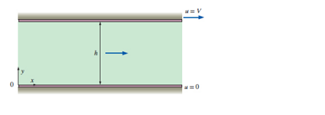
FIGURE P9-102
(a)
The velocity distribution is a superposition of Couette flow with a linear velocity distribution and Poiseuille flow with a parabolic velocity distribution.
Explanation of Solution
Given information:
The following figure shows that two infinite plates.
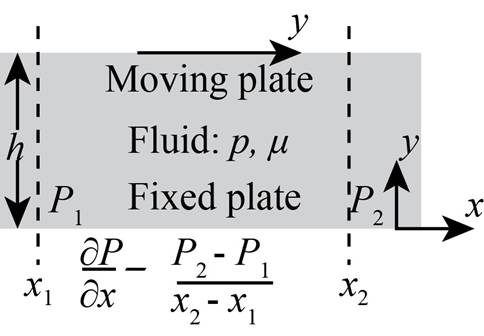
Figure-(1)
At the point of wall and fluid, the velocity of the fluid is equal to zero.
Write the expression for the pressure gradient.
Here, the arbitrary locations along the
Write the expression for
Here, the viscosity is
Write the expression for
Here, the density of the fluid is
Integrate Equation (II) with respect to
Here, the constant is
Integrate Equation (IV) with respect to
Here, the constant is
Integrate Equation (III) with respect to
Here, the constant is
The following figure represents planar Poiseuile flow.
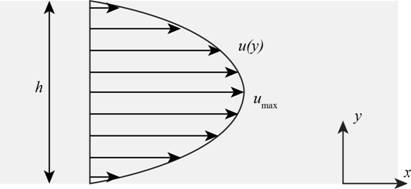
Figure (2)
Write the expression for dimensionless form of velocity field.
Here, the non- dimensional velocity along the arbitrary location along the
The Equation (VII) indicates that the pressure gradient is positive. If the both walls are stationary and pressure gradient is also there, then the flow should be planar Poiseuile flow.
Write the expression for non- dimensional velocity.
Write the expression for non- dimensional pressure.
Write the expression for non -dimensional distance
Calculation:
Substitute
Substitute
Substitute
The Equations (VII) indicates super position of the linear velocity profile
Substitute
(b)
The plot the
Answer to Problem 102P
The following Figure (4) represents the
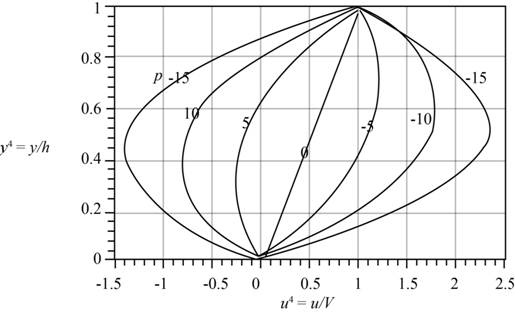
Explanation of Solution
At the point of wall and fluid, the velocity of the fluid is equal to zero.
Write the expression for the pressure gradient.
Here, the arbitrary locations along the
The following figure represents planar Poiseuile flow.
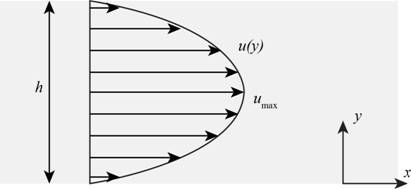
Figure (2)
Write the expression for dimensionless form of velocity field.
Here, the non dimensional velocities is
The Equation (VII) indicates that the pressure gradient is positive. If the both walls are stationary and pressure gradient is also there, then the flow should be planar Poiseuile flow.
Write the expression for non -dimensional velocity.
Write the expression for non -dimensional pressure.
The following figure represents the Couette flow between two parallel plates.

Figure-(3)
The pressure gradient is less than two, then pressure is decreasing in
Write the expression for non dimensional distance
Substitute
The following table represents the pressure gradient and x or y non- dimensional distance.
| | | |
| | | |
| | | |
| | | |
The following figure represents between
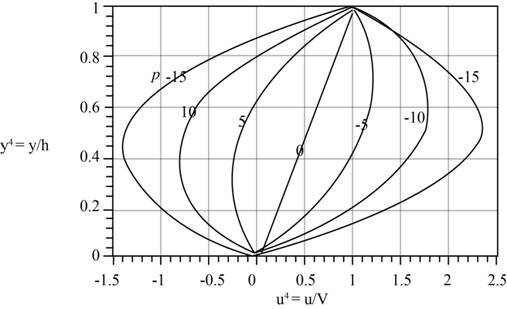
Figure (4)
The Figure (4) indicates that the pressure gradient is positive. If the both walls are stationary and pressure gradient is also there, then the flow should be planar Poiseuile flow.
Conclusion:
The following Figure (4) represents the
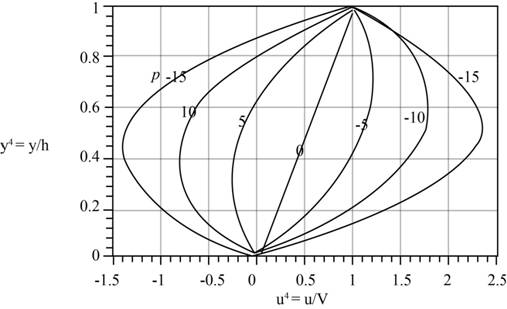
(c)
The position and magnitude of maximum dimensionless velocity.
Answer to Problem 102P
The expression for the pressure of fluid 1 is
The expression for the pressure of fluid
Explanation of Solution
Assume, at the point of wall and fluid, the velocity of the fluid is equal to zero.
Write the expression for velocity of the fluid 1,
Here, the velocity of fluid 1 is
Assume, the velocity of the fluid 2 at the free surface of the wall is equal to the velocity of the moving plates.
Write the expressions for the velocity of fluid 2.
Here, the velocity of fluid 2 is
Write the expression for velocity at interface.
Write the expression for rate of shear stress.
Here, the kinematic coefficient of fluid is
Write the expression for the shear stress acting on fluid
Here, the kinematic coefficient of fluid 1 is
Write the expression for the shear stress acting on fluid 2.
Here, the kinematic coefficient of fluid 2 is
Write the expression for the rate of shear stress at interface.
Write the expression for pressure at the bottom of the flow,
Here, the pressure is
Write the expression for the pressure at the interface of fluid 1.
Here, the pressure at the fluid 1 is
Write the expression for the pressure at the interface of fluid 2.
Here, the pressure at the fluid 1 is
At the interface of the fluid the pressure cannot have discontinuity and the surface is ignored.
Write the expression for the pressure at interface of fluid.
Here, the velocity of flow for fluid
Write the expression for
Here, the density of the fluid 1 is
Write the expression for
Here, the density of the fluid 2 is
Calculation:
Integrate Equation (XXVII) with respect to
Here, the constant is
Substitute
Substitute
Integrate Equation (XXVIII) with respect to
Here, the constant is
Substitute
Substitute
Substitute
Conclusion:
The expression for the pressure of fluid 1 is
The expression for the pressure of fluid 2 is
(d)
The position and magnitude of the maximum dimensionless velocity.
Answer to Problem 102P
The position of the maximum dimensionless velocity is
The magnitude of the maximum dimensionless velocity is
Explanation of Solution
Given information:
Write the expression for the position of the velocity.
Here, the viscosity of the fluid is
The following figure represents positions of the velocities.
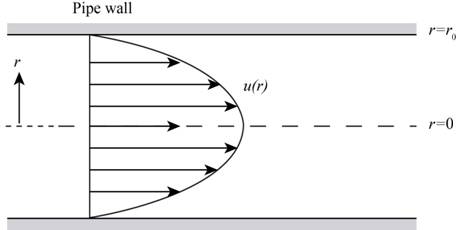
Figure-(5)
Write the expression for the radial velocity
Here, the maximum velocity is
The following figure represents the magnitude of the velocity.
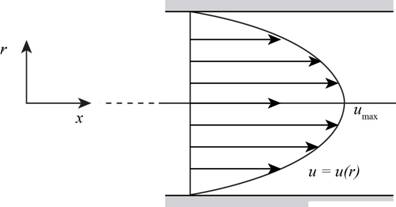
Figure-(6)
Write the expression for magnitude.
Here the magnitude is
Substitute
Conclusion:
The position of the maximum dimensionless velocity is
The magnitude of the maximum dimensionless velocity is
Want to see more full solutions like this?
Chapter 9 Solutions
Connect Access for Fluid Mechanics
- Explain the fundamental differences between a flow domain and a control volume.arrow_forwardConsider a flow field in polar coordinates, where the stream function isgiven as ψ = ψ(r, θ). Starting with the concept of mass flow betweentwo streamlines, derive your answer.arrow_forwardIn your own words, c. Explain why the stream function ψ is restricted to 2-D flows and you have to use the velocity potential ζ to define 3-D flows.arrow_forward
- For each statement, choose whether the statement is true or false, and discuss your answer briefly. (a) The velocity potential function can be defined for threedimensional flows. (b) The vorticity must be zero in order for the stream function to be defined. (c) The vorticity must be zero in order for the velocity potential function to be defined. (d) The stream function can be defined only for two-dimensional flow fields.arrow_forwardConsider dimensionless velocity distribution in Couette flow (which is also called generalized Couette flow) with an applied pressure gradient which is obtained in the following form as attached, where u, V, ∂P/∂x, and h represent fluid velocity, upper plate velocity, pressure gradient, and distance between parallel plates, respectively. Also, u* , y* , and P* represent dimensionless velocity, dimensionless distance between the plates, and dimensionless pressure gradient, respectively. (a) Explain why the velocity distribution is a superposition of Couette flow with a linear velocity distribution and Poiseuille flow with a parabolic velocity distribution. (b) Show that if P*>2, backflow begins at the lower wall and it never occurs at the upper wall. Plot u* versus y* for this situation. (c) Find the position and magnitude of maximum dimensionless velocity.arrow_forwardUnder what conditions do both the stream function ψ andthe velocity potential ϕ exist for a fl ow fi eld? When doesone exist but not the other?arrow_forward
- What flow property determines whether a region of flow is rotational or irrotational? Discuss.arrow_forwardQ#1: What is stream wise acceleration? How does it differ from normal acceleration? Can a fluid particle accelerate in steady flow? Express the Bernoulli equation in three different ways using (a) energies, (b) pressures, and (c) heads.arrow_forwardExplain why the incompressible flow approximation and the constant temperature approximation usually go hand in hand.arrow_forward
- Prove that three-dimensional source flow is irrotational.arrow_forwardAnswer completely Show how the Darcy-Weisbach equation can be derived from the Hagen-Poiseuille equation through the introduction of the Reynolds number. What is the friction factor, f, equal to for flow at a laminar condition? What is it equal to in other regimes of flow?arrow_forwardConsider two-dimensional flow in the xy-plane. What is the significance of the difference in value of stream function ? from one streamline to another?arrow_forward
 Elements Of ElectromagneticsMechanical EngineeringISBN:9780190698614Author:Sadiku, Matthew N. O.Publisher:Oxford University Press
Elements Of ElectromagneticsMechanical EngineeringISBN:9780190698614Author:Sadiku, Matthew N. O.Publisher:Oxford University Press Mechanics of Materials (10th Edition)Mechanical EngineeringISBN:9780134319650Author:Russell C. HibbelerPublisher:PEARSON
Mechanics of Materials (10th Edition)Mechanical EngineeringISBN:9780134319650Author:Russell C. HibbelerPublisher:PEARSON Thermodynamics: An Engineering ApproachMechanical EngineeringISBN:9781259822674Author:Yunus A. Cengel Dr., Michael A. BolesPublisher:McGraw-Hill Education
Thermodynamics: An Engineering ApproachMechanical EngineeringISBN:9781259822674Author:Yunus A. Cengel Dr., Michael A. BolesPublisher:McGraw-Hill Education Control Systems EngineeringMechanical EngineeringISBN:9781118170519Author:Norman S. NisePublisher:WILEY
Control Systems EngineeringMechanical EngineeringISBN:9781118170519Author:Norman S. NisePublisher:WILEY Mechanics of Materials (MindTap Course List)Mechanical EngineeringISBN:9781337093347Author:Barry J. Goodno, James M. GerePublisher:Cengage Learning
Mechanics of Materials (MindTap Course List)Mechanical EngineeringISBN:9781337093347Author:Barry J. Goodno, James M. GerePublisher:Cengage Learning Engineering Mechanics: StaticsMechanical EngineeringISBN:9781118807330Author:James L. Meriam, L. G. Kraige, J. N. BoltonPublisher:WILEY
Engineering Mechanics: StaticsMechanical EngineeringISBN:9781118807330Author:James L. Meriam, L. G. Kraige, J. N. BoltonPublisher:WILEY





